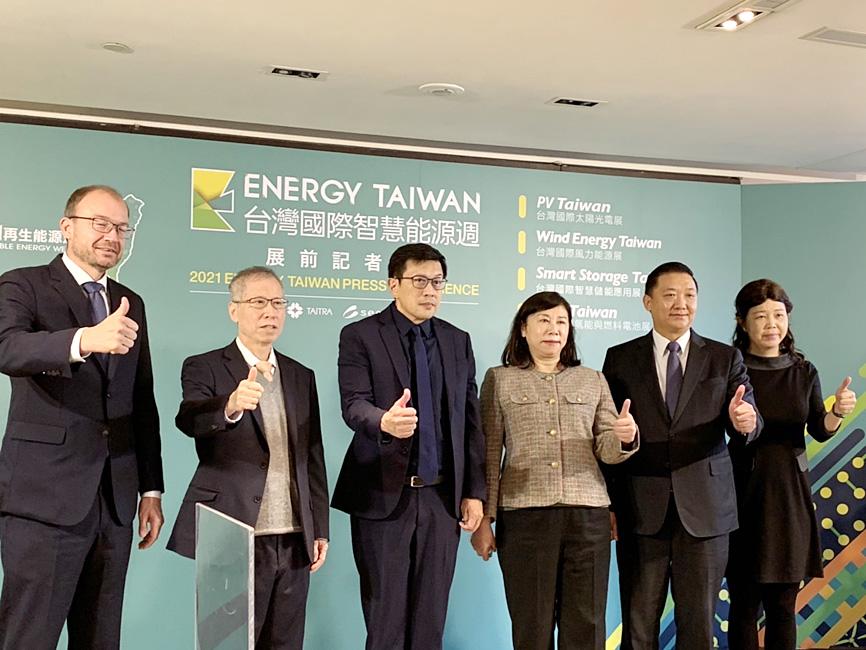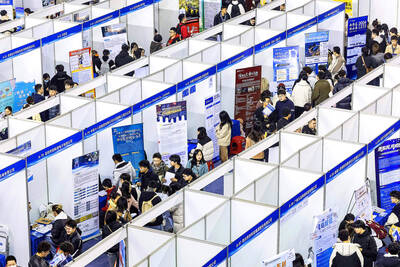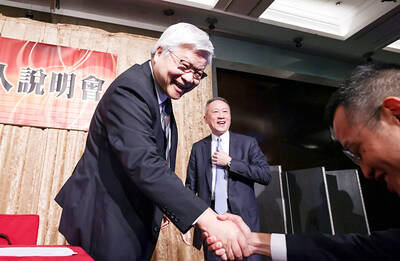Solar module maker United Renewable Energy Co (聯合再生能源) yesterday said it aims to develop 30 percent more solar energy capacity totaling 300 megawatts (MW) next year by turning fish ponds and barren farmland into solar power facilities.
The Hsinchu-based company attributed the growth to the government’s efforts to shift to renewable energy sources from coal-fired energy by 2025.
This year, United Renewable Energy has landed about 400 solar projects with combined capacity of 230MW through collaboration with local governments.

Photo: Chang Hui-wen, Taipei Times
The company has won bids to install solar arrays atop rooftops at schools, parking lots, government-owned dormitories, as well as floating panels on fish ponds, it said.
As more solar power facilities are to be completed and connected to the electricity grid, United Renewable Energy expects to book income of NT$2.5 billion (US$90.02 million) from selling about 100MW of solar power next year, it said.
It is also making inroads into the solar storage segment and is to showcase a shipping container-sized large-capacity modular battery pack at the Energy Taiwan trade show, which starts today and finishes on Friday at the Nangang Exhibition Center’s Hall 2 in Taipei.
United Renewable Energy chairman Sam Hong (洪傳獻) called on the government to plan a renewable energy storage policy before the capacity of feeders, deployed by Taiwan Power Co (Taipower, 台電), reaches its limit of 10 gigawatts (GW).
Solar power and other forms of renewable energy are interconnected to Taipower’s electricity grids through feeder installations.
“With energy storage systems, solar power can ensure stable power supply and play a bigger role in the nation’s electricity supply, rather than being an alternative,” Hong said.
The government should offer more incentives — such as tax breaks on equipment investments or boosting feed-in tariffs — to encourage the adoption of energy storage, he said.
With just 6.6GW of solar energy capacity deployed so far, Hong said that the government is in “a dire situation” regarding its goal of building 20GW of solar energy infrastructure by 2025.
The government should accelerate the release of under-utilized land for solar panel installations, he said.
The firm said it estimates that 20,000 hectares are required to install enough solar panels for 20GW of capacity, while there are 400,000 hectares of abandoned farmland.
Separately, GreenPeak Renewables Co (鑫世紀國際開發), a solar energy platform backed by leading alternative investment firm Stonepeak Infrastructure Partners, yesterday signed a syndicated loan of NT$ 2.1 billion with KGI Bank (凱基銀行), E.Sun Commercial Bank (玉山銀行) and Taipei Fubon Commercial Bank (台北富邦銀行) to fund its Yu Chang Solar Project (昱昶能源太陽發電光電廠).
Yu Chang is expected to produce 58 million kilowatt-hours per year, reducing carbon emissions by an amount equivalent to planting the number of trees in 75 Daan Forest Parks, GreenPeak Renewables said in a statement.
The Yunlin County-based project is expected to provide energy to more than 14,000 households, or the equivalent of 7 percent of the county’s power demand, it said.

Stephen Garrett, a 27-year-old graduate student, always thought he would study in China, but first the country’s restrictive COVID-19 policies made it nearly impossible and now he has other concerns. The cost is one deterrent, but Garrett is more worried about restrictions on academic freedom and the personal risk of being stranded in China. He is not alone. Only about 700 American students are studying at Chinese universities, down from a peak of nearly 25,000 a decade ago, while there are nearly 300,000 Chinese students at US schools. Some young Americans are discouraged from investing their time in China by what they see

MAJOR DROP: CEO Tim Cook, who is visiting Hanoi, pledged the firm was committed to Vietnam after its smartphone shipments declined 9.6% annually in the first quarter Apple Inc yesterday said it would increase spending on suppliers in Vietnam, a key production hub, as CEO Tim Cook arrived in the country for a two-day visit. The iPhone maker announced the news in a statement on its Web site, but gave no details of how much it would spend or where the money would go. Cook is expected to meet programmers, content creators and students during his visit, online newspaper VnExpress reported. The visit comes as US President Joe Biden’s administration seeks to ramp up Vietnam’s role in the global tech supply chain to reduce the US’ dependence on China. Images on

New apartments in Taiwan’s major cities are getting smaller, while old apartments are increasingly occupied by older people, many of whom live alone, government data showed. The phenomenon has to do with sharpening unaffordable property prices and an aging population, property brokers said. Apartments with one bedroom that are two years old or older have gained a noticeable presence in the nation’s six special municipalities as well as Hsinchu county and city in the past five years, Evertrust Rehouse Co (永慶房產集團) found, citing data from the government’s real-price transaction platform. In Taipei, apartments with one bedroom accounted for 19 percent of deals last

US CONSCULTANT: The US Department of Commerce’s Ursula Burns is a rarely seen US government consultant to be put forward to sit on the board, nominated as an independent director Taiwan Semiconductor Manufacturing Co (TSMC, 台積電), the world’s largest contract chipmaker, yesterday nominated 10 candidates for its new board of directors, including Ursula Burns from the US Department of Commerce. It is rare that TSMC has nominated a US government consultant to sit on its board. Burns was nominated as one of seven independent directors. She is vice chair of the department’s Advisory Council on Supply Chain Competitiveness. Burns is to stand for election at TSMC’s annual shareholders’ meeting on June 4 along with the rest of the candidates. TSMC chairman Mark Liu (劉德音) was not on the list after in December last